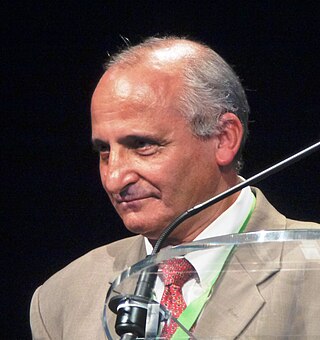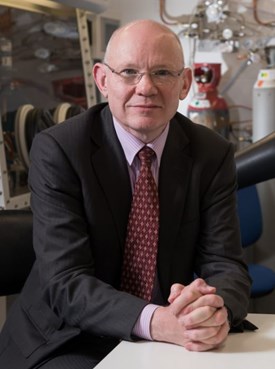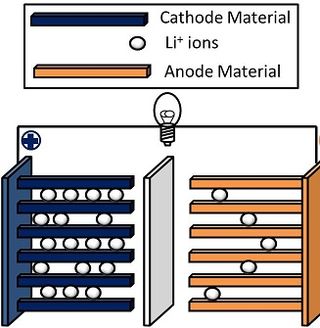
A lithium-ion or Li-ion battery is a type of rechargeable battery which uses the reversible reduction of lithium ions to store energy. The negative electrode of a conventional lithium-ion cell is typically graphite, a form of carbon. This negative electrode is sometimes called the anode as it acts as an anode during discharge. The positive electrode is typically a metal oxide; the positive electrode is sometimes called the cathode as it acts as a cathode during discharge. Positive and negative electrodes remain positive and negative in normal use whether charging or discharging and are therefore clearer terms than anode and cathode, which are reversed during charging.

John Bannister Goodenough was an American materials scientist, a solid-state physicist, and a Nobel laureate in chemistry. He was a professor of Mechanical, Materials Science, and Electrical Engineering at the University of Texas at Austin. He is widely credited with the identification and development of the lithium-ion battery, for developing the Goodenough–Kanamori rules in determining the sign of the magnetic superexchange in materials, and for seminal developments in computer random-access memory.

Lithium metal batteries are primary batteries that have metallic lithium as an anode. These types of batteries are also referred to as lithium-metal batteries after lithium-ion batteries had been invented. Most lithium metal batteries are non-rechargeable. However, rechargeable lithium metal batteries are also under development. Since 2007, Dangerous Goods Regulations differentiate between lithium metal batteries and lithium-ion batteries.

Lithium iron phosphate or lithium ferro-phosphate (LFP) is an inorganic compound with the formula LiFePO
4. It is a gray, red-grey, brown or black solid that is insoluble in water. The material has attracted attention as a component of lithium iron phosphate batteries, a type of Li-ion battery. This battery chemistry is targeted for use in power tools, electric vehicles, solar energy installations and more recently large grid-scale energy storage.

Lithium cobalt oxide, sometimes called lithium cobaltate or lithium cobaltite, is a chemical compound with formula LiCoO
2. The cobalt atoms are formally in the +3 oxidation state, hence the IUPAC name lithium cobalt(III) oxide.

Rachid Yazami is a Moroccan scientist, engineer, and inventor. He is best known for his critical role in the development of the graphite anode for lithium-ion batteries and his research on fluoride ion batteries.
A potassium-ion battery or K-ion battery is a type of battery and analogue to lithium-ion batteries, using potassium ions for charge transfer instead of lithium ions. It was invented by the Iranian/American chemist Ali Eftekhari in 2004.
The sodium-ion battery (NIB or SIB) is a type of rechargeable battery that uses sodium ions (Na+) as its charge carriers. In some cases, its working principle and cell construction are similar to those of lithium-ion battery (LIB) types, but it replaces lithium with sodium as the cathode material, which belongs to the same group in the periodic table as lithium and thus has similar chemical properties.

Akira Yoshino is a Japanese chemist. He is a fellow of Asahi Kasei Corporation and a professor at Meijo University in Nagoya. He created the first safe, production-viable lithium-ion battery which became used widely in cellular phones and notebook computers. Yoshino was awarded the Nobel Prize in Chemistry in 2019 alongside M. Stanley Whittingham and John B. Goodenough.

Sir Peter George Bruce, is a British chemist, and Wolfson Professor of Materials in the Department of Materials at the University of Oxford. In 2018, he was appointed as Physical Secretary and Vice President of the Royal Society. Bruce is a founder and Chief Scientist of the Faraday Institution.
Aluminium-ion batteries are a class of rechargeable battery in which aluminium ions serve as charge carriers. Aluminium can exchange three electrons per ion. This means that insertion of one Al3+ is equivalent to three Li+ ions. Thus, since the ionic radii of Al3+ (0.54 Å) and Li+ (0.76 Å) are similar, significantly higher numbers of electrons and Al3+ ions can be accepted by cathodes with little damage. Al has 50 times (23.5 megawatt-hours m-3) the energy density of Li and is even higher than coal.
Michael Makepeace Thackeray is a South African chemist and battery materials researcher. He is mainly known for his work on electrochemically active cathode materials. In the mid-1980s he co-discovered the manganese oxide spinel family of cathodes for lithium ion batteries while working in the lab of John Goodenough at the University of Oxford. In 1998, while at Argonne National Laboratory, he led a team that first reported the NMC cathode technology. Patent protection around the concept and materials were first issued in 2005 to Argonne National Laboratory to a team with Thackeray, Khalil Amine, Jaekook Kim, and Christopher Johnson. The reported invention is now widely used in consumer electronics and electric vehicles.
Research in lithium-ion batteries has produced many proposed refinements of lithium-ion batteries. Areas of research interest have focused on improving energy density, safety, rate capability, cycle durability, flexibility, and cost.
Magnesium batteries are batteries that utilize magnesium cations as the active charge transporting agents in solution and often as the elemental anode of an electrochemical cell. Both non-rechargeable primary cell and rechargeable secondary cell chemistries have been investigated. Magnesium primary cell batteries have been commercialised and have found use as reserve and general use batteries.
Jeff Dahn is a Professor in the Department of Physics & Atmospheric Science and the Department of Chemistry at Dalhousie University. He is recognized as one of the pioneering developers of the lithium-ion battery, which is now used worldwide in laptop computers, cell-phones, cars and many other mobile devices. Although Dr. Dahn made numerous contribution to the development of lithium-ion batteries, his most important discovery was intercalation of Li+ ions into graphite from solvents comprising ethylene carbonate, which was the final piece of the puzzle in the invention of commercial Li-ion battery. Nevertheless, Dahn was not selected for the 2019 Nobel Prize in Chemistry, which recognized only John Goodenough, M. Stanley Whittingham and Akira Yoshino.
The glass battery is a type of solid-state battery. It uses a glass electrolyte and lithium or sodium metal electrodes. The battery was invented by John B. Goodenough, inventor of the lithium cobalt oxide and lithium iron phosphate electrode materials used in the lithium-ion battery (Li-ion), and Maria H. Braga, an associate professor at the University of Porto and a senior research fellow at Cockrell School of Engineering at The University of Texas.
Linda Faye Nazar is a Senior Canada Research Chair in Solid State Materials and Distinguished Research Professor of Chemistry at the University of Waterloo. She develops materials for electrochemical energy storage and conversion. Nazar demonstrated that interwoven composites could be used to improve the energy density of lithium–sulphur batteries. She was awarded the 2019 Chemical Institute of Canada Medal.

Lithium nickel manganese cobalt oxides (abbreviated NMC, Li-NMC, LNMC, or NCM) are mixed metal oxides of lithium, nickel, manganese and cobalt with the general formula LiNixMnyCo1-x-yO2. These materials are commonly used in lithium-ion batteries for mobile devices and electric vehicles, acting as the positively charged cathode.
Arumugam Manthiram is an American materials scientist and engineer, best known for his identification of the polyanion class of lithium ion battery cathodes, understanding of how chemical instability limits the capacity of layered oxide cathodes, and technological advances in lithium sulfur batteries. He is a Cockrell Family Regents Chair in engineering, Director of the Texas Materials Institute, the Director of the Materials Science and Engineering Program at the University of Texas at Austin, and a former lecturer of Madurai Kamaraj University. Manthiram delivered the 2019 Nobel Lecture in Chemistry on behalf of Chemistry Laureate John B. Goodenough.

This is a history of the lithium-ion battery.











